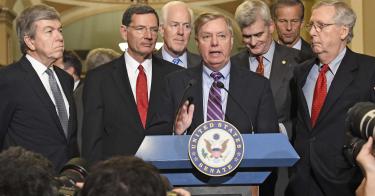Since January, Republicans in Congress have been working on efforts to repeal and replace Obamacare using the budget reconciliation vehicle.
As a last-ditch effort to utilize this legislative vehicle before it expires on Sept. 30, Congress looks likely to vote next week on the Graham-Cassidy health bill that partially repeals and replaces parts of Obamacare.
While this bill falls short of fully repealing Obamacare and replacing it with a new patient-centered system, it is probably the last viable attempt to begin unwinding Obamacare’s glaring failures. The Graham-Cassidy bill has some critical issues the Senate must fix in order to ensure it improves the status quo, but it is certainly a bill worth fixing.
What the Bill Does
The Graham-Cassidy bill repeals the individual and employer mandate tax penalties in Obamacare, provides Medicaid reform, and empowers states to design health care subsidies and insurance rules that work for their residents.
>>>> How to Ensure that the Graham–Cassidy Bill Expands Markets and Choice in Health Care—Not Government Programs
These provisions are a good first step in addressing Obamacare’s damage and allowing states to pursue reforms of their insurance markets and Medicaid programs.
However, the bill retains the Obamacare levels of spending as well as major Obamacare taxes, including taxes that directly drove up the cost of health care.
The bill keeps the spending to create a state block grant program, which will be funded with all of the current federal Obamacare spending for subsidizing exchange coverage through tax credits and cost-sharing reductions, and about 75 percent of the current Obamacare funding for expanding Medicaid to cover able-bodied adults.
The upside of this framework: It transfers to states the responsibility to ensure that individuals who do not have employment-based health coverage can access insurance. This is a significant reversal from Obamacare’s top-down, federal government-centric approach.
The Critical Fixes Needed
The Senate needs to make changes to the block grant program in order to fulfill the sponsors’ stated intent of promoting “market-based solutions.”
As written, nothing would prevent states from using the money to simply expand government health programs, which could result in transferring up to 8 million people (half of the people in the individual market) from private coverage into government-run programs with no consumer choice.
To guarantee patients have choice and options in health insurance, the Senate should change Graham-Cassidy to preclude states’ ability to use the new block grants to force individuals into a government-run program that lacks choice.
Specifically, the Senate should delete language that allows states to spend the new federal grant funding to (1) expand Medicaid, (2) pay medical providers directly for providing services, and (3) contract with managed-care plans to cover specified groups.
Any of these options would inherently result in adding more people either to existing programs or to new programs that are effectively government-controlled monopolies without consumer choice.
Without such changes, states are likely to spend the funding in ways that expand the number of people in government health care programs rather than providing subsidies to help recipients purchase the coverage of their choice in a competitive private market with a variety of different plan options.
The pattern of the Obamacare Medicaid expansion and the Children’s Health Insurance Program before it show that, with very few exceptions, states historically have used federal funding for health insurance coverage simply to expand one-size-fits-all government programs.
Liberals are pushing for more government control of health care through a single-payer system, which would be a disaster. So it is imperative now more than ever for policymakers to continue to promote access to mainstream private insurance for more Americans, rather than open the door to additional government program expansions.
Improving the Status Quo
If the Senate makes the recommended changes mentioned above in the block grant program, the Graham-Cassidy bill will provide an improvement over the status quo.
Even with these recommended changes, many more actions are needed to achieve a truly patient-centered health care system in our country. While this bill allows for more state flexibility, there is still much more to do at the federal level to restore free-market principles in other facets of health policy, including Medicare and the tax treatment of health insurance.
Members of Congress should not be under any illusion that passing Graham-Cassidy relieves them of the burden of continuing to reform our nation’s health care system in a more patient-centered, market-based direction.
This piece originally appeared in The Daily Signal



